Preparation Nano-Structure Polytetrafluoroethylene (PTFE) Functional Film on the Cellulose Insulation Polymer and Its Effect on the Breakdown Voltage and Hydrophobicity Properties
Abstract
:1. Introduction
2. Materials and Methods
2.1. Materials and Sample Preparation
2.2. Characterization Methods and Sample Treatment
3. Results and Discussions
3.1. XPS Analysis
3.2. Surface Topography Analysis
3.3. XRD Analysis
3.4. DC Breakdown Analysis
3.5. Hydrophobicity and Hygroscopicity Analysis
3.6. Oil Absorption and Impregnation
4. Conclusions
Author Contributions
Funding
Conflicts of Interest
References
- CIGRE Joint Working Group A2/B4.28. HVDC Converter Transformers Guide Lines for Conducting Design Reviews for HVDC Converter Transformers; CIGRE: Paris, France, 2010. [Google Scholar]
- CIGRE Joint Working Group A2/B4.28. HVDC Converter Transformers Design Review, Test Procedures, Ageing Evaluation and Reliability in Service; CIGRE: Paris, France, 2010. [Google Scholar]
- Smith, R.C.; Liang, C.; Landry, M.; Nelson, J.K.; Schadler, L.S. The mechanisms leading to the useful electrical properties of polymer nanodielectrics. IEEE Trans. Dielectr. Electr. Insul. 2008, 15, 187–196. [Google Scholar] [CrossRef]
- Tanaka, T. Dielectric Breakdown in Polymer Nanocomposites. In Polymer Nanocomposites; Springer: Berlin, Germany, 2016. [Google Scholar]
- Yan, S.; Liao, R.; Yang, L.; Zhao, X.; Yuan, Y.; He, L. Influence of nano-Al2O3 on electrical properties of insulation paper under thermal aging. In Proceedings of the IEEE International Conference on High Voltage Engineering and Application, Chengdu, China, 19–22 September 2016; pp. 1–4. [Google Scholar]
- He, L.; Liao, R.; Lv, Y.; Yang, L.; Zhao, X.; Yan, S. Effect of nano-Al2O3 on the thermal aging physicochemical properties of insulating paper. In Proceedings of the IEEE International Conference on Condition Monitoring and Diagnosis, Xi’an, China, 25–28 September 2016; pp. 254–257. [Google Scholar]
- Liao, R.; He, L.; Lü, Y.; Zhao, X.; Yuan, Y. Influence of nano-Al2O3 on properties of oil-paper insulation during thermal aging process. Trans. China Electrotech. Soc. 2017, 32, 207–215. [Google Scholar]
- Liu, H.; Chi, M.; Chen, Q.; Gao, Z.; Zhu, X.; Wei, X. Analysis of dielectric characteristics of nano-Al2O3 modified insulation pressboard. Zhongguo Dianji Gongcheng Xuebao/Proc. Chin. Soc. Electr. Eng. 2017, 37, 4246–4253. [Google Scholar]
- Liao, R.; Yuan, L.; Zhang, F.; Yang, L.; Wang, K.; Duan, L. Preparation of montmorillonite modified insulation paper and study on its electrical characteristics. High Volt. Eng. 2014, 40, 33–39. [Google Scholar]
- Chi, M.; Tao, K.; Chen, Q.; Liu, H.; Gao, P.; Gao, Z. Dielectric properties of nano-montmorillonite modified insulation pressboard. High Volt. Eng. 2017, 43, 2842–2848. [Google Scholar]
- Hao, J.; Chen, G.; Liao, R. Influence of moisture and temperature on space charge dynamics in multilayer oil-paper insulation. IEEE Trans. Dielectr. Electr. Insul. 2012, 19, 1456–1464. [Google Scholar] [CrossRef]
- Oommen, T.V. Moisture equilibrium charts for transformer insulation drying practice. IEEE Trans. Power App. Syst. 1984, PAS-103, 3063–3067. [Google Scholar] [CrossRef]
- Emsley, A.M.; Stevens, G.C. Review of chemical indicators of degradation of cellulosic electrical paper insulation in oil-filled transformers. IEEE Proc. Sci. Meas. Technol. 1994, 141, 324–334. [Google Scholar] [CrossRef]
- Emsley, A.M.; Xiao, X.; Heywood, R.J.; Ali, M. Degradation of cellulosic insulation in power transformers. Part 3: Effects of oxygen and water on ageing in oil. IEEE Proc. Sci. Meas. Technol. 2000, 147, 115–119. [Google Scholar] [CrossRef]
- Lundgaard, L.E.; Hansen, W.; Linhjell, D.; Painter, T.J. Aging of oil-impregnated paper in power transformers. IEEE Trans. Power Deliv. 2004, 19, 230–239. [Google Scholar] [CrossRef]
- Yong, J.; Fang, Y.; Chen, F.; Huo, J.; Yang, Q.; Bian, H.; Du, G.; Hou, X. Femtosecond laser ablated durable superhydrophobic PTFE films with penetrating microholes for oil/water separation: Separating oil from water and corrosive solutions. Appl. Surf. Sci. 2016, 389, 1148–1155. [Google Scholar] [CrossRef]
- Toosi, S.F.; Moradi, S.; Kamal, S.; Hatzikiriakos, S.G. Superhydrophobic laser ablated PTFE substrates. Appl. Surf. Sci. 2015, 349, 715–723. [Google Scholar] [CrossRef]
- Yang, L.J.; Liao, R.J.; Sun, C.X.; Zhu, M.Z. Influence of vegetable oil on the thermal aging of transformer paper and its mechanism. IEEE Trans. Dielectr. Electr. Insul. 2012, 18, 692–700. [Google Scholar] [CrossRef]
- Hou, W.; Wang, Q. Stable polytetrafluoroethylene superhydrophobic surface with lotus-leaf structure. J. Colloid Interface Sci. 2009, 333, 400–403. [Google Scholar] [CrossRef] [PubMed]
- Park, B.H.; Lee, M.H.; Kim, S.B.; Jo, Y.M. Evaluation of the surface properties of PTFE foam coating filter media using XPS and contact angle measurements. Appl. Surf. Sci. 2011, 257, 3709–3716. [Google Scholar] [CrossRef]
- Liao, R.J.; Tang, C.; Yang, L.J.; Grzybowski, S. Thermal aging micro-scale analysis of power transformer pressboard. IEEE Trans. Dielectr. Electr. Insul. 2008, 15, 1281–1287. [Google Scholar] [CrossRef]
- Liu, L.; Wang, X.; Xie, W.; Mingming, Y.U.; Fang, L.; Li, H.; Yang, M.; Xiao, Y.; Ren, M.; Sun, J. Properties of polysulfonamide fiber/polytetrafluoroethylene composites. J. Shanghai Univ. 2017, 23, 185–191. [Google Scholar]
- Vandencasteele, N.; Reniers, F. Plasma-modified polymer surfaces: characterization using XPS. J. Electron Spectrosc. Relat. Phenom. 2010, 178, 394–408. [Google Scholar] [CrossRef]
- Hare, E.F.; Shafrin, E.G.; Zisman, W.A. Properties of Films of Adsorbed Fluorinated Acids. J. Phys. Chem. 1954, 58, 236–239. [Google Scholar] [CrossRef]
- De Toit, F.J.; Sanderson, R.D.; Engelbrecht, W.J.; Wagener, J.B. The effect of surface fluorination on the wettability of high density polyethylene. J. Fluor. Chem. 1995, 74, 43–48. [Google Scholar] [CrossRef]
- Alia, M.; Emsley, A.M.; Herman, H.; Heywood, R.J. Spectroscopic studies of the ageing of cellulosic paper. Polymer 2001, 42, 2893–2900. [Google Scholar] [CrossRef]
- Hinterstoisser, B.; Salmen, L. Application of dynamic 2D FTIR to cellulose. Vib. Spectrosc. 2000, 22, 111–118. [Google Scholar] [CrossRef]
- Liao, R.; Lin, Y.; Guo, P.; Liu, H.B.; Xia, H.H. Thermal aging effects on the moisture equilibrium curves of mineral and mixed oil-paper insulation systems. IEEE Trans. Dielectr. Electr. Insul. 2015, 22, 842–850. [Google Scholar] [CrossRef]
- Liao, R.; Hao, J.; Chen, G.; Ma, Z.Q.; Yang, L.J. A comparative study of physicochemical, dielectric and thermal properties of pressboard insulation impregnated with natural ester and mineral oil. IEEE Trans. Dielectr. Electr. Insul. 2011, 18, 1626–1637. [Google Scholar] [CrossRef]




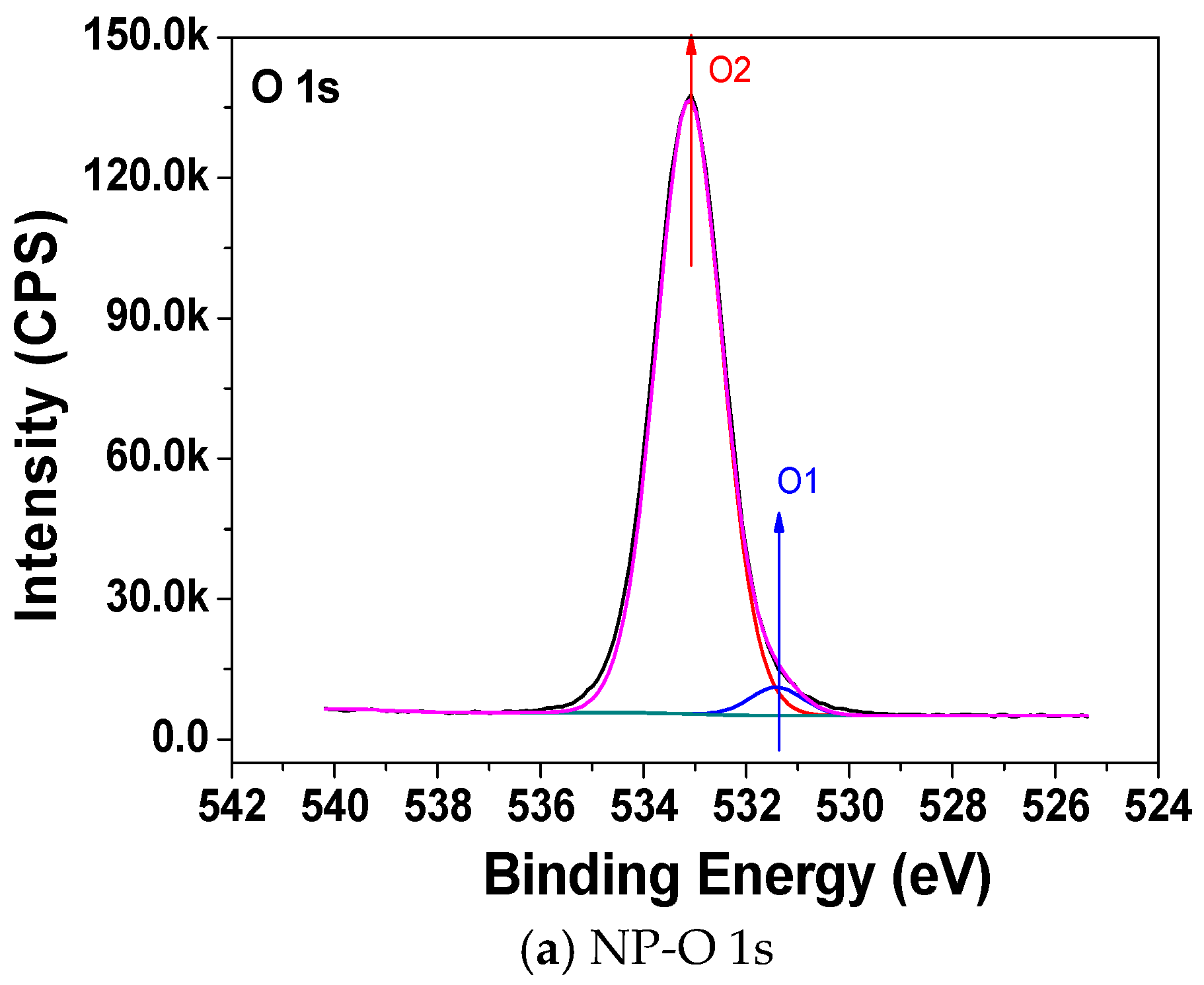
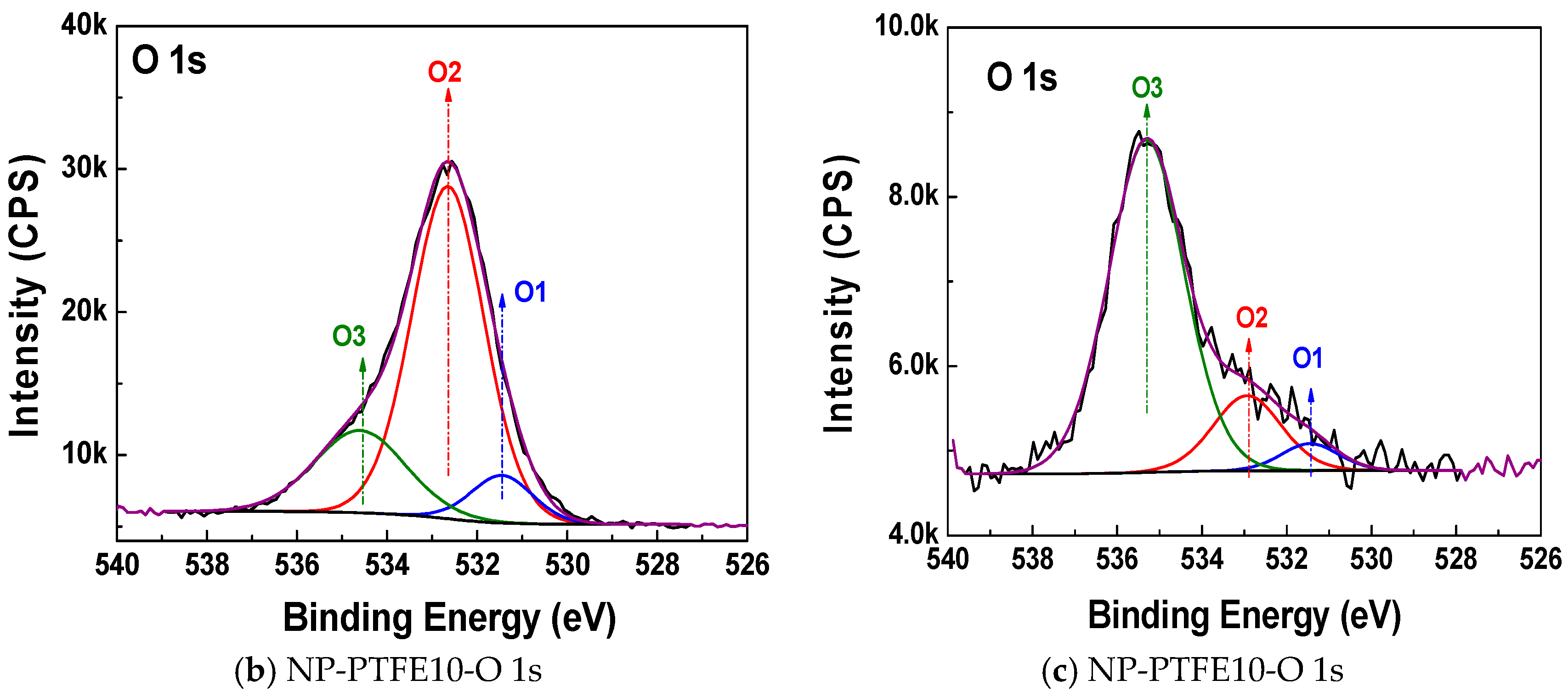
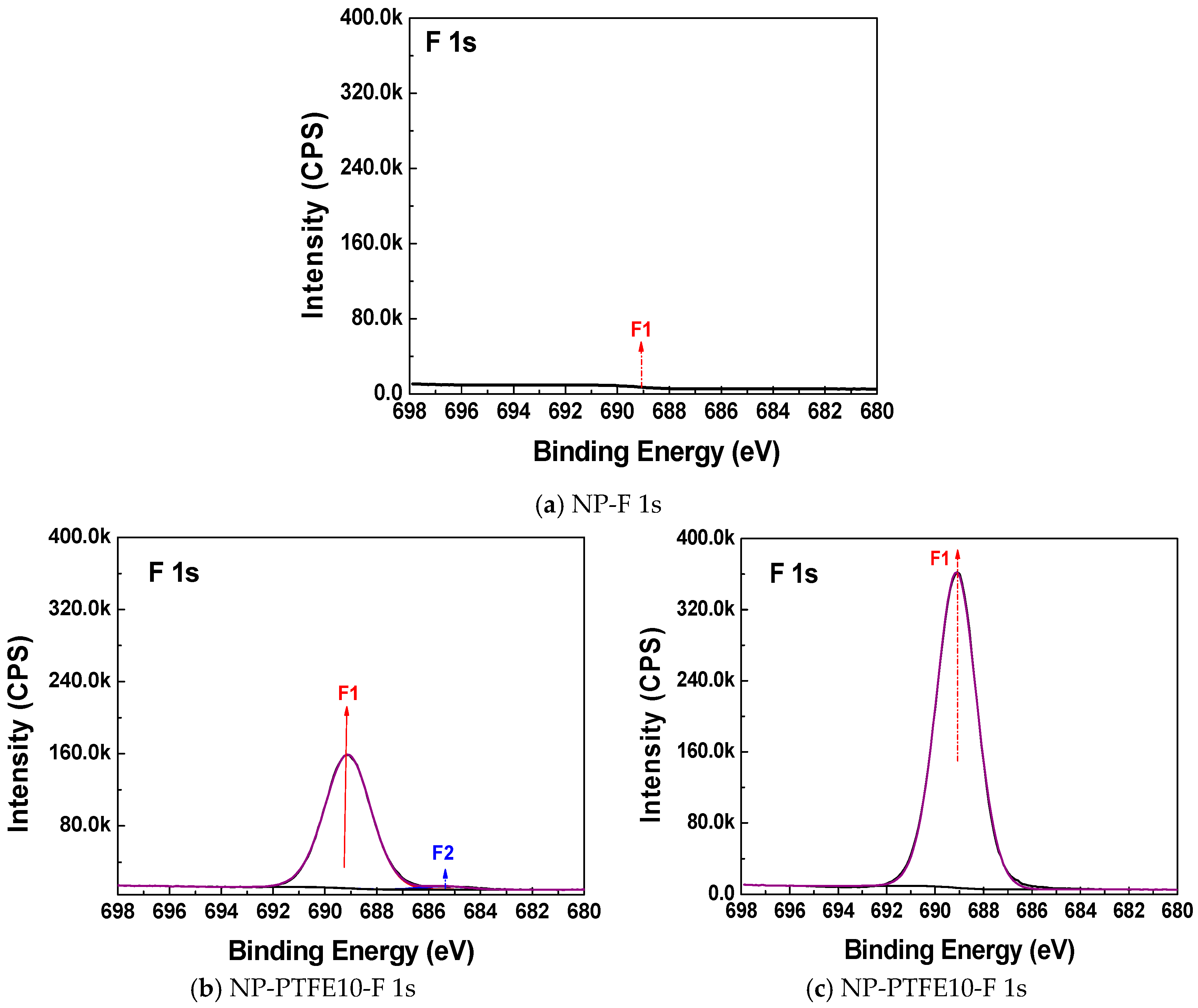



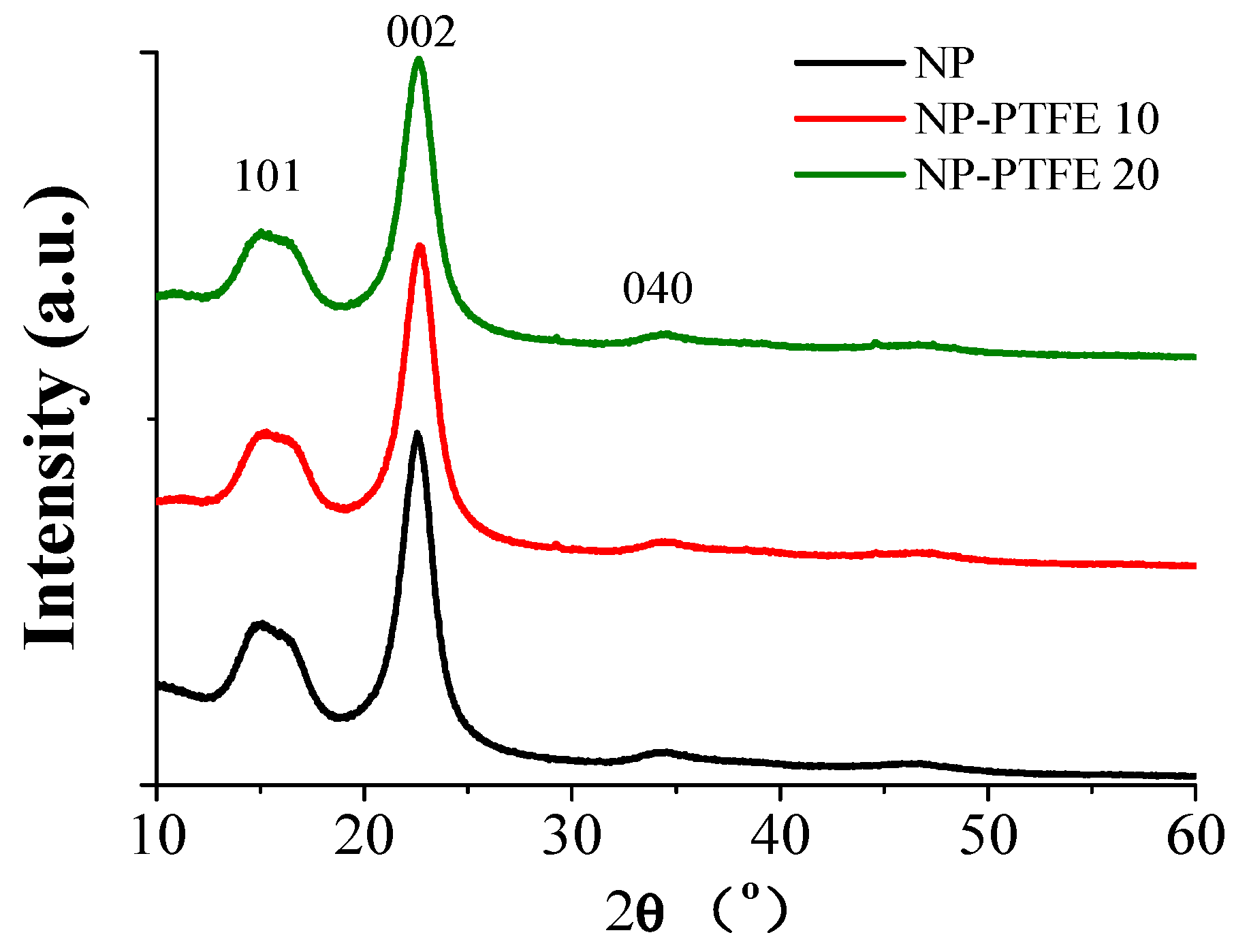




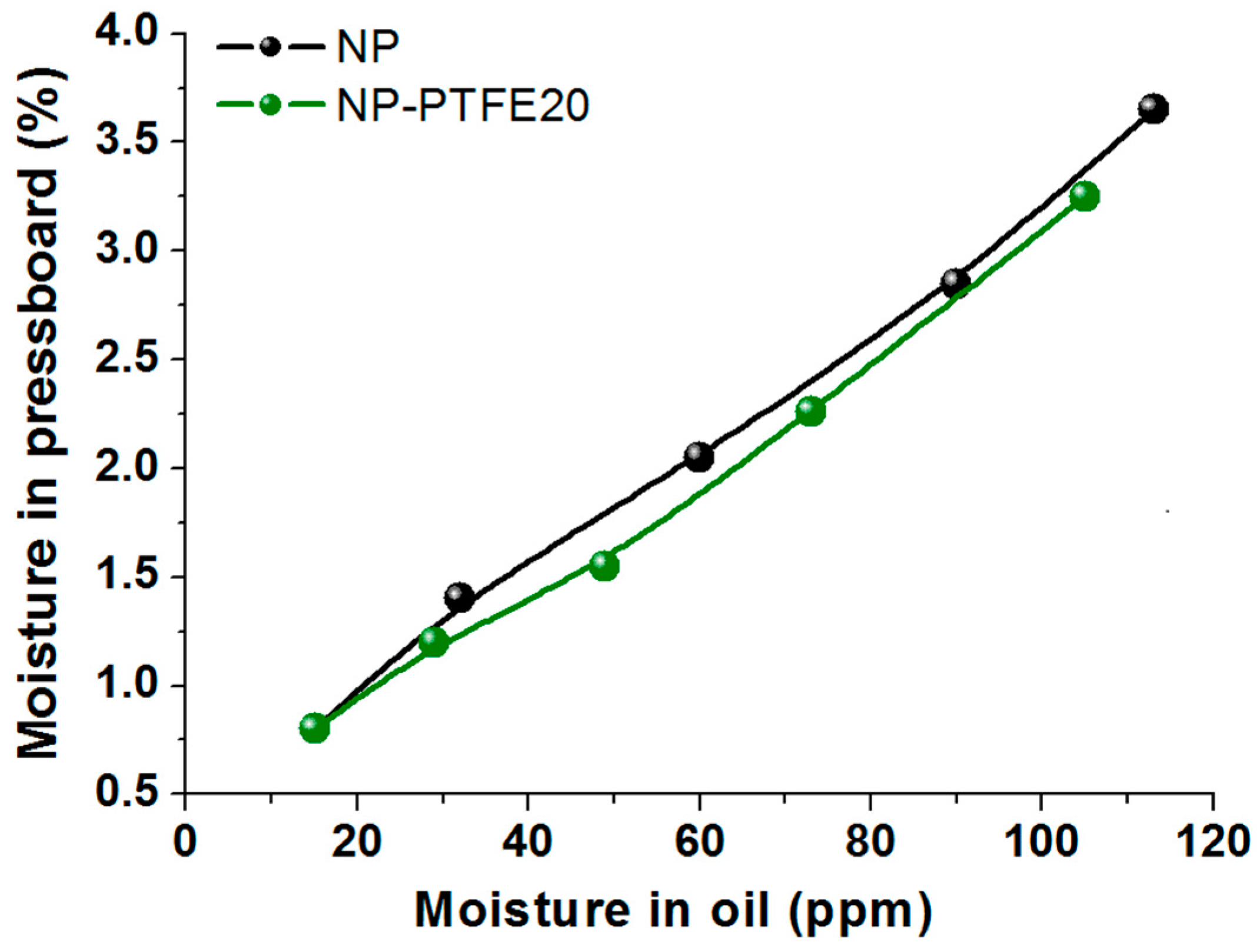


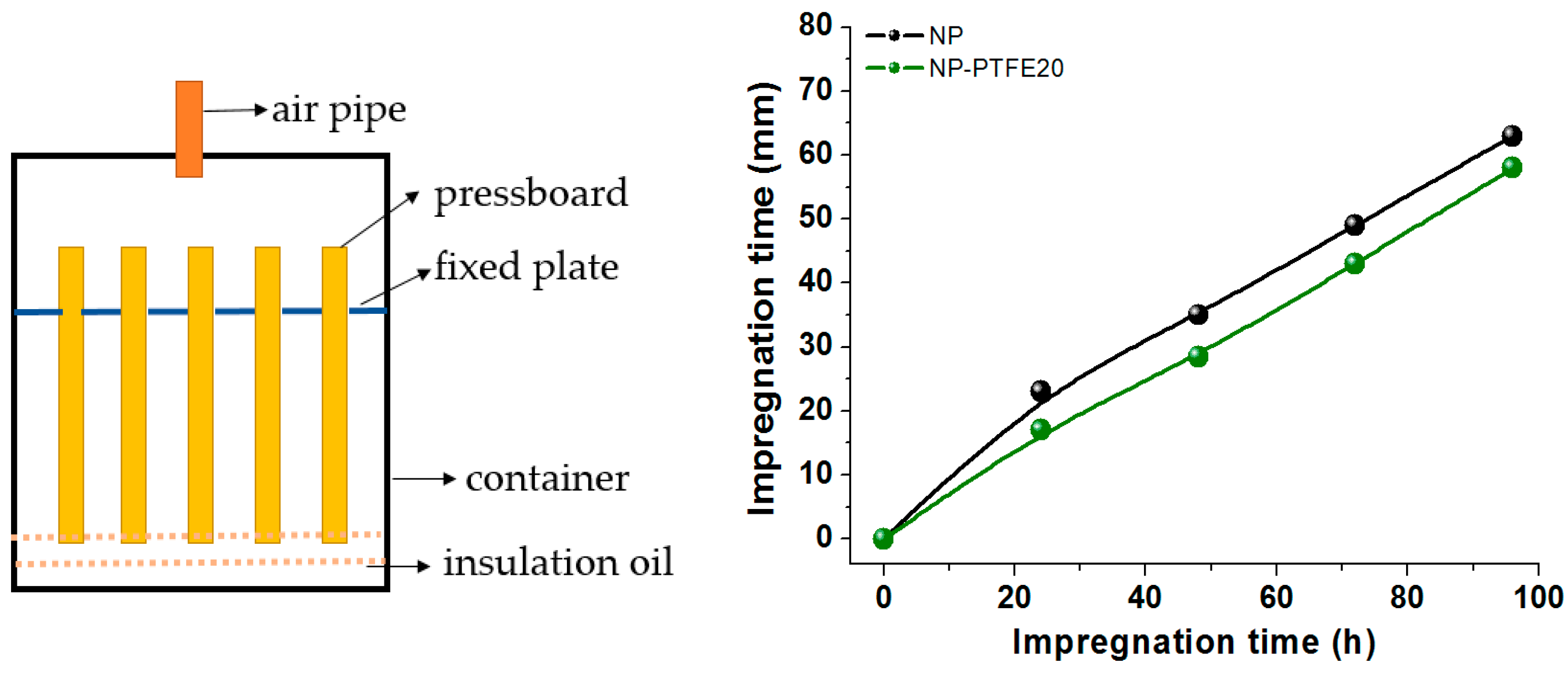
| Sample | Abbreviation |
|---|---|
| new pressboard | NP |
| new pressboard deposited PTFE for 10 min | NP-PTFE10 |
| new pressboard deposited PTFE for 20 min | NP-PTFE20 |
| Property | Mineral Oil |
|---|---|
| Kinematic viscosity 40 °C (mm2/s) | 9.7 |
| Acidity (mg KOH/g) | 0.008 |
| Breakdown voltage (2.5 mm gap electrodes) (kV) | 47.0 |
| Relative permittivity (50 Hz) | 2.2 |
| Moisture content (ppm) | 9 |
| Sample | Data Set | Name | Position | % Conc. |
|---|---|---|---|---|
| NP | C–C/C=C | C1 | 284.6 | 16.9 |
| C–O | C6 | 286.4 | 66.2 | |
| O–C=O | C7 | 287.9 | 16.9 | |
| NP-PTFE10 | C–C/C=C | C1 | 285.0 | 29.4 |
| O–C–CF3/CF2 | C2 | 287.4 | 14.0 | |
| C–F | C3 | 289.5 | 19.2 | |
| C–F2 | C4 | 291.8 | 20.5 | |
| C–F3 | C5 | 293.9 | 7.3 | |
| C–O | C6 | 286.6 | 7.7 | |
| O–C=O | C7 | 288.2 | 1.8 | |
| NP-PTFE20 | C–C/C=C | C1 | 284.6 | 1.9 |
| O–C–CF3/CF2 | C2 | 287.6 | 14.0 | |
| C–F | C3 | 289.7 | 24.2 | |
| C–F2 | C4 | 291.7 | 40.3 | |
| C–F3 | C5 | 293.8 | 18.0 | |
| C–O | C6 | 286.6 | 1.2 | |
| O–C=O | C7 | 288.2 | 0.3 |
| Sample | Data Set | Name | Position | % Conc. |
|---|---|---|---|---|
| NP | O=C–O | O1 | 531.4 | 3.6 |
| O–C | O2 | 533.1 | 96.4 | |
| NP-PTFE10 | O=C | O1 | 531.4 | 8.4 |
| O–C | O2 | 532.6 | 69.9 | |
| O–C–CF3/CF2 | O3 | 534.6 | 21.7 | |
| NP-PTFE20 | O=C | O1 | 531.4 | 4.8 |
| O–C | O2 | 532.9 | 16.2 | |
| O–C–CF3/CF2 | O3 | 535.3 | 79.0 |
| Sample | Data Set | Name | Position | % Conc. |
|---|---|---|---|---|
| NP | / | / | / | / |
| NP-PTFE10 | F2–C | F1 | 689.1 | 97.5 |
| F–C | F2 | 685.4 | 2.5 | |
| NP-PTFE20 | F2–C | F1 | 689.1 | 100.0 |
© 2018 by the authors. Licensee MDPI, Basel, Switzerland. This article is an open access article distributed under the terms and conditions of the Creative Commons Attribution (CC BY) license (http://creativecommons.org/licenses/by/4.0/).
Share and Cite
Hao, J.; Liu, C.; Li, Y.; Liao, R.; Liao, Q.; Tang, C. Preparation Nano-Structure Polytetrafluoroethylene (PTFE) Functional Film on the Cellulose Insulation Polymer and Its Effect on the Breakdown Voltage and Hydrophobicity Properties. Materials 2018, 11, 851. https://doi.org/10.3390/ma11050851
Hao J, Liu C, Li Y, Liao R, Liao Q, Tang C. Preparation Nano-Structure Polytetrafluoroethylene (PTFE) Functional Film on the Cellulose Insulation Polymer and Its Effect on the Breakdown Voltage and Hydrophobicity Properties. Materials. 2018; 11(5):851. https://doi.org/10.3390/ma11050851
Chicago/Turabian StyleHao, Jian, Cong Liu, Yanqing Li, Ruijin Liao, Qiang Liao, and Chao Tang. 2018. "Preparation Nano-Structure Polytetrafluoroethylene (PTFE) Functional Film on the Cellulose Insulation Polymer and Its Effect on the Breakdown Voltage and Hydrophobicity Properties" Materials 11, no. 5: 851. https://doi.org/10.3390/ma11050851





